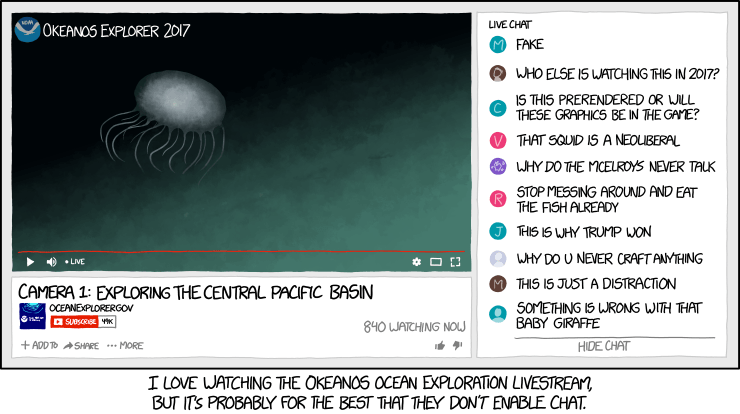Interactive and Real-Time Engagement
By Katie Fleeman / 3 minute read
There are a number of ways you can engage with your audience in real time. You can provide a mediation layer between researchers and the audience, or provide insights into how the journalists reported on a science story:
- Tweet chats: Interview or conversation, usually between two or more Twitter accounts and organized with a specific hashtag. The “interviewer” account will tweet a question, and the “interviewee” will reply to that tweet with an answer. (Another live “text” event is the Reddit AMA — see below.) Example: In #STATMadnessChats, “contestants” in the annual STAT Madness bracket converse with @statnews through their institutional Twitter handles to discuss their research innovations.
- Livestreams: Many social-media platforms include a “livestream” product, which can either be a live broadcast or the debut of a produced work. These include YouTube Live, Facebook Live, and Instagram Live. Reporters, editors, and even sources can interact with viewers in real time, either by responding in the comment section or by “on air” callouts. Example: Nova, on PBS, premieres documentaries (such as Polar Extremes) on Facebook Live, and the brand account, producers, and researchers will chime in during the airing with plugs for related videos and behind-the-scenes tidbits.
- Virtual events: Panels, webinars, and lectures are broadcast virtually (say, via Zoom). These often include some sort of presentation or structured discussion, followed by Q&As with the audience. Example: Spectrum, a website on autism research, hosts webinars for researchers across different disciplines. As the Covid-19 pandemic hit, Spectrum hosted a discussion with researchers on how institutional shutdowns were affecting their work.

A few tips:
- Start to schedule well in advance. Academics typically have busy schedules, and you may need time to wrangle all parties, especially if you want to feature multiple scientists.
- Vet your speakers beforehand. Your editors and reporters can be a good resource for flagging which scientists communicate well on the fly.
- Set expectations about how general your audience will be. This will help researchers know how deep into the weeds they can go.
- Promote beforehand. Create a Facebook event; lean on your panelists and their institutions’ marketing teams to promote the event; work with movers and shakers in the field
- Make sure the technology works! Test it out beforehand.
It feels special when you’re an audience member, and you put in a question, and somebody actually reads it and you get an answer.
Chelsey Coombs, engagement editor, Spectrum
Reddit AMAs
AMAs, or “Ask Me Anything” sessions, take place on a subreddit — a community on Reddit dedicated to a particular topic, and can last anywhere from 60 minutes to 24 hours. Benji Rosen, of MIT Technology Review, explains how they coordinate these sessions within their specialties. (Q&A edited and condensed for clarity):
Why do an AMA?
Often it points back to reporting that we’ve done, so it’s a little payoff. But mostly it’s just a way for us to follow the conversation on the subreddit, to get a pulse about what people are curious about.
How hands-on are you with the sources?
Many of our sources have never done this, and they don’t know what it is. So I’m coaching them on best practices and what to expect, and then just following the conversation for them and alerting them to what’s being talked about and what comments I think are the best, just to streamline the process to make it a little bit easier on them.
And what are some of those best practices?
Don’t kill yourself. Don’t go in there thinking that you have to chat with users for 10 or 12 hours — just check in two or three times over the course of the chat. Maybe answer like five or six questions per time. Have it be thoughtful, show people how to follow you elsewhere or get in touch with us to continue the conversation. People [the potential sources] balk when they hear it’s a 24-hour chat,* but once they realize that it’s like an intermittent chat, where you can check in and check out, it makes it a lot more manageable.
Here is an example of an AMA that was hosted by MIT Technology Review to discuss its Covid Tracing Tracker.
*Not every AMA runs on this 24-hour timetable, and your approach to prepping sources may need to be different. Social Media Examiner recommends prepping for a one-hour AMA by brainstorming potential questions so you are ready to go.


